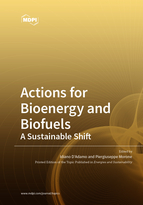Topic Menu
► Topic MenuTopic Editors


Actions for Bioenergy and Biofuels: A Sustainable Shift

A printed edition is available here.
Topic Information
Dear Colleagues,
The pandemic period has led to a socioeconomic crisis that will have serious repercussions on production systems as well as on the life habits of citizens. Added to this is the pollution caused by fossil fuels and concerns about damage to health and the environment. However, it is precisely in times of difficulty that it is necessary to identify a turning point and introduce a paradigmatic shift able to reconcile wellbeing with environmental and health protection. Increased citizen awareness, new employment outlets, growing economic opportunities associated with sustainable management of natural resources, as well as a growing respect for ecosystems point at sustainability as a key driver of recovery. Within this framework, this Special Issue aims to focus on the strategies, practices, and actions that allow implementation of a sustainable energy system based on bioenergy production. Particular emphasis will be given to biofuels, since the transport sector is responsible for a significant share of CO2 emissions, but sustainable development should include all sectors and contributions of various stakeholders at global level. Contributions to this Topic can address both micro [1] and macro [2] research questions.
Contributions to this SI should consider (but not be limited to) the following points:
- The use of raw materials that follow sustainability criteria and do not conflict with land use for agricultural products.
- Supply chain analysis, clarifying that only a life cycle approach to a product is able to define its actual sustainability.
- Industrial symbiosis and energy communities as an effective element of collaboration among energy users.
- The definition of the willingness to pay for green or circular products compared to conventional fossil-based products.
- The identification of business models to suggest how to implement initiatives that go beyond the protection of the environment.
- The involvement of citizens, and in particular younger generations, in this epoch-making sustainable transition.
- The implementation of policies that support the development of bioenergy and biofuels.
Theoretical, methodological, and practical studies are welcomed to this Topic.
References
[1] D’Adamo, I.; Falcone, P.M.; Huisingh, D.; Morone, P.; A circular economy model based on biomethane: What are the opportunities for the municipality of Rome and beyond? Renew. Energy 2021, 163, 1660–1672. https://doi.org/10.1016/j.renene.2020.10.072.
[2] D’Adamo, I.; Falcone, P.M.; Morone, P.; A new socio-economic indicator to measure the performance of bioeconomy sectors in Europe. Ecol. Econ. 2020, 176, 106724. https://doi.org/10.1016/j.ecolecon.2020.106724.
Prof. Dr. Idiano D'Adamo
Prof. Dr. Piergiuseppe Morone
Topic Editors
Keywords
- sustainability
- green economy
- circular economy
- bioeconomy
- bioenergy
- biofuel
- energy policy
Participating Journals
| Journal Name | Impact Factor | CiteScore | Launched Year | First Decision (median) | APC |
|---|---|---|---|---|---|

Energies
|
3.2 | 5.5 | 2008 | 16.1 Days | CHF 2600 |

Sustainability
|
3.9 | 5.8 | 2009 | 18.8 Days | CHF 2400 |

MDPI Topics is cooperating with Preprints.org and has built a direct connection between MDPI journals and Preprints.org. Authors are encouraged to enjoy the benefits by posting a preprint at Preprints.org prior to publication:
- Immediately share your ideas ahead of publication and establish your research priority;
- Protect your idea from being stolen with this time-stamped preprint article;
- Enhance the exposure and impact of your research;
- Receive feedback from your peers in advance;
- Have it indexed in Web of Science (Preprint Citation Index), Google Scholar, Crossref, SHARE, PrePubMed, Scilit and Europe PMC.

